Lifestyle
Achieve a Radiant Tan With Herbal Boosts
Perfect your tanning routine with herbal boosts and discover how to enhance your glow while keeping your skin healthy and radiant.

To achieve a radiant tan, you should consider using herbal boosts that nourish and enhance your skin. Ingredients like Aloe Vera gel and Coconut Oil hydrate while Hemp Seed Oil provides essential fatty acids, making them great for all skin types. Natural bronzers, such as Black Walnut Shell, can enhance your tan for a deeper glow. Always match your tanning lotion to your skin type for the best results. Staying hydrated and using sunscreen are also key to maintaining that perfect tan. There's plenty more to explore about maximizing your tanning routine and keeping your skin healthy.
Key Takeaways
- Utilize herbal accelerators containing Aloe Vera, Hemp Seed Oil, and Coconut Oil to nourish and hydrate your skin while tanning.
- Opt for natural bronzers like Black Walnut Shell to enhance your tanning results effectively.
- Choose a tanning lotion that matches your skin type for optimal effects and minimal irritation.
- Stay hydrated and apply post-tan moisturizers infused with Aloe or Chamomile for better tan retention.
Understanding Herbal Accelerators
Herbal accelerators are your skin's best friends, packed with essential vitamins and natural ingredients that boost tanning while nourishing and hydrating your skin. They work as natural bronzers and dark tanning accelerators, making your skin glow without harsh chemicals.
Key ingredients like Aloe Vera gel, Hemp Seed Oil, and Coconut Oil are vital for keeping your skin soft and hydrated. These hypoallergenic formulations minimize irritation, making them perfect for sensitive skin.
With herbal accelerators, you're applying a superfood smoothie for your skin, enhancing its health and appearance. Products containing natural bronzers, like Black Walnut Shell, amplify your bronzing effects, ensuring a radiant, vacation-like glow while caring for your skin at the same time.
Choosing the Right Tanning Lotion
Choosing the right tanning lotion starts with understanding your skin type to guarantee ideal results.
If you have dry skin, look for lotions with hydrating ingredients like Aloe Vera or Coconut Oil.
For oily skin, opt for lightweight, non-comedogenic formulas that won't clog your pores.
Sensitive skin types should prioritize hypoallergenic options to minimize irritation.
If you're aiming for a deeper tan, consider bronzer tanning lotions that enhance your glow without harsh chemicals.
Always check product reviews to find proven formulations.
Finally, confirm the lotion contains vitamin C for an added boost to your skin's radiance.
Remember to keep your options open for returns if the product doesn't suit your needs, allowing you to find the perfect match.
Maximizing Tanning Bed Results

To achieve the best results from your tanning bed sessions, it's essential to use high-quality lotions that enhance your tan while nourishing your skin.
Opt for herbal enhancers like Beta Carotene and consider brands like Aussie Gold for quicker, richer bronzing. Look for lotions with natural bronzers and skin-loving ingredients to boost your results.
Don't forget to stay hydrated by drinking plenty of water, as it helps maintain skin moisture.
After tanning, apply aloe or chamomile-infused lotions to soothe and nourish your skin.
To protect against UV rays, always use a broad-spectrum sunscreen.
Common Tanning Mistakes to Avoid
Avoiding common tanning mistakes is essential for achieving a safe and radiant glow without damaging your skin. Here are some pitfalls you should steer clear of:
| Mistake | Solution |
|---|---|
| Choosing random products | Match lotion to your skin type |
| Skipping sunscreen | Always apply, even indoors |
| Ignoring skin reactions | Monitor and adjust accordingly |
| Overexposing to UV | Limit your exposure time |
| Not following instructions | Read and adhere to guidelines |
UV Exposure Limits Explained

Understanding UV exposure limits is essential for protecting your skin while achieving that desired tan. Each skin type reacts differently to UV rays, so it's important to know your personal limits.
If you have fair skin, you'll need to limit your exposure considerably, while darker skin can tolerate more. Always monitor your skin's reaction during tanning sessions and adjust your time accordingly.
Don't skip sunscreen, even indoors; it's critical for safeguarding against harmful rays. Be aware that certain medications may increase your skin's sensitivity, so consult your healthcare provider if unsure.
Stick to FDA guidelines for safe tanning practices, ensuring you enjoy your tan without jeopardizing your skin's health. Your skin deserves the best care!
Benefits of Natural Ingredients
Natural ingredients in tanning products not only provide a radiant glow but also nourish and hydrate your skin, ensuring a healthier tanning experience. By choosing products rich in natural ingredients, you're investing in your skin's health while achieving that sun-kissed look.
| Ingredient | Benefits | Skin Type |
|---|---|---|
| Aloe Vera Gel | Hydrates and soothes skin | All skin types |
| Hemp Seed Oil | Rich in omega fatty acids | Dry/Sensitive |
| Coconut Oil | Moisturizes and softens skin | All skin types |
| Black Walnut Shell | Enhances bronzing effects | All skin types |
Using these natural ingredients helps you maintain skin elasticity and prevents dryness, making your tanning experience both beautiful and beneficial.
Tips for Post-Tan Care

To keep your tan looking fresh and vibrant, prioritize hydration and gentle care for your skin after tanning.
Start by drinking plenty of water to maintain moisture levels. Use a nourishing moisturizer with ingredients like Aloe Vera or Coconut Oil daily to keep your skin soft and supple.
Avoid hot showers, as they can strip oils and fade your tan; opt for lukewarm water instead. When exfoliating, choose a gentle scrub to remove dead skin without disrupting your tan.
Always apply broad-spectrum sunscreen before heading outdoors to protect your skin from UV damage. Finally, consider using a tan extender lotion to prolong your glow and maintain an even color.
With these tips, your radiant tan will last longer and look stunning!
Frequently Asked Questions
Can I Use Herbal Tanning Products on Sensitive Skin?
Yes, you can use herbal tanning products on sensitive skin. Just make certain they're hypoallergenic and free from harsh chemicals. Always patch-test first to check for any reactions before applying it more widely.
How Long Will My Tan Last With Herbal Accelerators?
Your tan can last anywhere from a week to ten days with herbal accelerators. Proper skincare, hydration, and using tan extenders help maintain that glow longer, ensuring you enjoy your radiant look.
Are Herbal Tanning Products Suitable for All Skin Types?
Yes, herbal tanning products can be suitable for all skin types, but you should choose formulations specifically designed for your skin type. Always check for hypoallergenic options to minimize irritation and guarantee a safe tanning experience.
Can I Mix Different Tanning Lotions for Better Results?
Mixing multiple tanning lotions might maximize your melanin magic, but be cautious. Combine compatible products carefully to avoid unwanted reactions. Always test a small area first to guarantee your skin stays smooth and stunning!
Do Herbal Accelerators Work Without Sun Exposure?
Herbal accelerators can enhance your skin's appearance even without sun exposure, thanks to their nourishing ingredients. They provide hydration and a subtle glow, making your skin look healthy and radiant while offering a natural bronzing effect.
Conclusion
Now that you're equipped with the knowledge of herbal boosts and natural ingredients, why not transform your tanning routine into a nourishing experience?
By choosing the right products and being mindful of your UV exposure, you can achieve that stunning, sun-kissed glow while keeping your skin healthy and hydrated.
Embrace this skin-loving ritual, and watch as your confidence soars with every radiant tan.
Get ready to step into the sun and shine like never before!
Lifestyle
How Cultural Diaspora Shapes Fusion Cuisine Trends
Savor the intriguing ways cultural diaspora influences fusion cuisine trends, as new flavors emerge and redefine our culinary landscape—discover what’s next!

Cultural diaspora shapes fusion cuisine by blending diverse culinary techniques and ingredients, creating unique dining experiences. As people migrate, they bring their flavors, enriching local cuisines with new tastes. You might notice dishes like Korean tacos or sushi burritos that reflect this vibrant interplay of cultures. Chefs often experiment with combining traditional recipes and contemporary techniques, appealing to adventurous diners craving innovative flavors. Plus, the rise of food trucks and pop-up restaurants encourages this culinary creativity. If you're curious about how these trends continue to evolve, you'll find even more exciting insights about the future of fusion cuisine.
Key Takeaways
- Cultural diaspora facilitates the introduction of diverse culinary techniques and ingredients, enriching local cuisines through cross-cultural exchanges.
- Immigrants adapt traditional recipes, leading to innovative dishes that reflect blended culinary traditions and local tastes.
- Ethnic restaurants serve as cultural ambassadors, promoting heritage and fostering appreciation for global flavors within host countries.
- Globalization enhances accessibility to international ingredients, encouraging experimentation and creativity in fusion cuisine.
- Sustainability trends drive the use of local ingredients and responsible cooking practices, reflecting environmental awareness in culinary innovations.
Cultural Diffusion Explained

Cultural diffusion plays an essential role in shaping the culinary landscape we enjoy today. This process involves the spread of cultural beliefs and practices, primarily through trade, migration, and conquest, which influences global cuisine.
You might notice how fusion cuisine blends culinary traditions, creating innovative dishes that highlight flavors from different cultures. For instance, Indo-Chinese and Tex-Mex are perfect examples of how diverse culinary practices can merge. Brazilian cuisine also exemplifies this blend, showcasing regional variations that reflect the country's rich cultural tapestry.
Consider the historical spice trade, where spices from India transformed European culinary practices, broadening their flavor profiles. This cultural exchange didn't just stop there; today, you can find creative dishes like the sushi burrito, combining traditional recipes with local ingredients.
This ongoing cultural diffusion continues to shape food culture, allowing you to explore new cooking techniques and diverse flavors.
Fusion Cuisine Evolution

The evolution of fusion cuisine reflects the dynamic interplay of cultures in the culinary world. Since the 1980s, chefs like Wolfgang Puck and Roy Yamaguchi have blended culinary traditions, giving rise to terms like Pan-Asian and Cal-Asian. This cultural diffusion has allowed innovative dishes such as Korean tacos and Japanese-Peruvian ceviche to emerge, showcasing diverse flavor profiles shaped by immigrant populations.
As globalization continues to intertwine food cultures, culinary creativity flourishes. Younger diners are particularly drawn to fusion cuisine, seeking unique dining experiences that challenge conventional boundaries. Food trucks and casual dining spots are at the forefront of this movement, experimenting with daring combinations that reflect a more accepting attitude toward culinary innovation.
Here's a quick look at the key elements driving the evolution of fusion cuisine:
| Aspect | Description |
|---|---|
| Cultural Influences | Blending of diverse culinary traditions |
| Innovative Dishes | Creation of new, hybrid dishes |
| Immigrant Populations | Impact of diverse communities on culinary trends |
| Globalization | Increased accessibility to global ingredients |
| Dining Experiences | Adventurous and unique dining options |
As fusion cuisine evolves, it promises to remain a crucial part of our culinary landscape.
Influences of Migration

Migration reshapes culinary landscapes by introducing new ingredients and cooking methods to host countries. For instance, traditional Indonesian desserts like Kue Putu and Dadar Gulung reflect the rich flavors that immigrant communities bring to their new homes.
As communities blend, you'll see how culinary traditions evolve, giving rise to exciting fusion cuisine. This transformation often leads to innovative dishes that reflect a mix of cultural heritage.
Here are three key influences of migration on food trends:
- Diverse Ingredients: Immigrants bring local ingredients from their home countries, enriching the culinary scene and inspiring chefs to experiment with flavors.
- Culinary Mashups: Unique combinations like Korean-Mexican tacos or Japanese-Peruvian ceviche showcase how cultural interactions inspire creativity in cooking.
- Ethnic Restaurants as Cultural Ambassadors: These establishments not only serve traditional dishes but also adapt recipes to local tastes, creating a bridge between communities.
Through migration, culinary practices expand, allowing you to savor dishes that celebrate both heritage and innovation.
As you explore these fusion cuisines, you'll discover how migrant communities shape food trends, bringing new life to local dining experiences. The result is a vibrant tapestry of flavors, reflecting the dynamic nature of our ever-evolving global food landscape.
Indian Diaspora Contributions

From the bustling streets of London to the vibrant markets of Dubai, the Indian diaspora has made a remarkable impact on global cuisine. By introducing traditional Indian flavors and culinary traditions, it's enriched local cuisines in various countries.
For instance, dishes like Mushroom Masala showcase how earthy flavors can be enhanced through spices, making them appealing to diverse palates. Indian expatriate chefs have led this evolution through cultural exchange, adapting traditional recipes with local ingredients to create innovative dishes like Indian-inspired sushi and curry pasta.
Indian restaurants worldwide act as cultural ambassadors, showcasing the richness of Indian culinary heritage and contributing to local economies. These establishments often feature diverse menus that blend traditional and contemporary Indian dishes, reflecting the global food movement's dynamics.
Events and festivals celebrating Indian cuisine in cities like Dubai further highlight the contributions of the Indian community, bringing together Indian flavors and local culinary practices.
Moreover, the emphasis on vegetarianism within Indian cuisine is gaining traction globally. Chefs are innovating plant-based dishes that honor traditional practices while appealing to contemporary dining trends.
This focus on sustainability not only attracts food enthusiasts but also solidifies the Indian diaspora's role in shaping fusion cuisine across the globe.
Culinary Mash-Ups Today
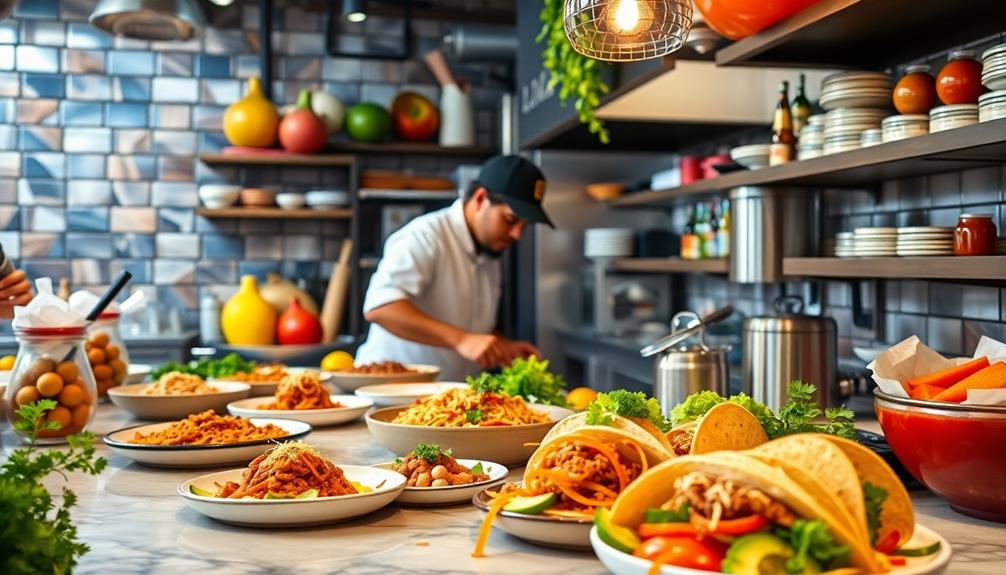
Culinary mash-ups today reflect a broader trend of blending diverse food cultures, taking inspiration from innovations like the Cronut® and ramen burgers.
These creative combinations push the boundaries of traditional cooking styles, offering bold flavors that resonate with adventurous eaters. Food trucks and Quick Service Restaurants (QSRs) are at the forefront, crafting innovative dishes that highlight local ingredients and the cultural significance of various cuisines.
Here are three notable examples of today's culinary mash-ups:
- Korean Tacos: A fusion of Korean BBQ and traditional Mexican tacos, showcasing a blend of spices and textures.
- Sushi Burritos: Wrapping sushi ingredients in a burrito format, this dish combines the best of both worlds, attracting fans of diverse culinary traditions.
- Waffle Tacos: An inventive take on breakfast, merging waffles and tacos for a sweet-savory delight.
Despite concerns about the focus on novelty over quality, these culinary creations continue to thrive, reflecting a sustained consumer interest in fusion food that celebrates a community or region's rich culinary heritage.
Future Trends in Fusion Cuisine

The future of fusion cuisine is bright, driven by a dynamic interplay of globalization and cultural exchange. As migration continues to shape culinary landscapes, you can expect chefs to create innovative fusion dishes that blend traditional culinary techniques with local ingredients.
This evolution caters to diverse palates and embraces the rise of third-culture cuisine, where dining experiences celebrate various culinary heritages.
You'll notice adventurous flavors gaining traction, with dishes like Korean-Mexican tacos and Japanese-Peruvian ceviche becoming mainstream favorites, especially among younger audiences.
Social media and food influencers play an essential role in promoting these trends, as restaurants use technology to create buzz and engage customers in unique dining experiences.
Sustainability will also shape the future of fusion cuisine, as chefs increasingly advocate for environmentally responsible cooking practices.
They'll focus on sourcing local ingredients while exploring global flavors, ensuring that their fusion dishes not only tantalize taste buds but also respect the planet.
As these trends unfold, expect a vibrant culinary landscape that reflects the rich tapestry of our interconnected world, inviting you to explore and indulge in a diverse array of flavors and experiences.
Frequently Asked Questions
What Are the Cultural Roots to Fusion Cuisine?
Fusion cuisine's cultural roots lie in centuries of trade and migration. You'll find diverse culinary practices blending together, creating innovative dishes as immigrant populations introduce their traditional flavors, reflecting a rich tapestry of shared culinary heritage.
Why Has Fusion Cuisine Become so Popular?
Fusion cuisine's like a vibrant tapestry, weaving together flavors from around the world. You've embraced this culinary trend due to globalization, adventurous palates, and social media showcasing unique dishes that tantalize and excite your taste buds.
What Is Cultural Fusion in the Field of Food?
Cultural fusion in food means blending culinary traditions from different backgrounds, creating innovative dishes that highlight unique flavors. You'll often find exciting combinations that surprise your palate, reflecting both creativity and multicultural influences in dining.
How Does Culture Influence Food?
Culture influences food by shaping your tastes, cooking methods, and ingredient choices. When you embrace new traditions, you create unique dishes that reflect your experiences, enhancing your culinary journey and connecting you to diverse communities.
Conclusion
As you explore the vibrant world of fusion cuisine, you'll see how cultural diaspora weaves together flavors like a tapestry of stories. Just as spices traveled the Silk Road, today's culinary mash-ups reflect journeys of migration and innovation. Embrace the delicious possibilities ahead, where each bite is a celebration of diversity and creativity. The future of fusion cuisine isn't just on your plate; it's a shared experience that transcends borders and unites us all.
Lifestyle
The Impact of Food Packaging Transparency on Consumer Trust
Just how much does food packaging transparency influence your trust and purchasing decisions? Discover the surprising effects that could change your shopping habits.

Transparent food packaging greatly impacts your trust in the products you buy. It allows you to see the quality and freshness at a glance, enhancing your perception of safety and overall value. Consumers like you are more likely to choose organic options and support brands that prioritize environmental sustainability. Research shows that transparent packaging not only increases your purchase intentions but also fosters a deeper loyalty to brands. With clear visuals, you feel more empowered to make informed choices about your food. There's more to uncover about how transparency shapes consumer behavior and trust, so stick around to learn further insights.
Key Takeaways
- Transparent packaging enhances consumer trust by allowing direct inspection of food quality and ingredients.
- Visual clarity boosts perceptions of product quality, particularly for organic foods.
- Consumers exhibit higher purchase intentions when they can visually assess freshness and safety.
- Aesthetic appeal in transparent packaging correlates with increased brand loyalty and satisfaction.
- Eco-conscious consumers favor brands with transparent packaging, aligning with their values of sustainability and ethical sourcing.
Importance of Transparent Packaging
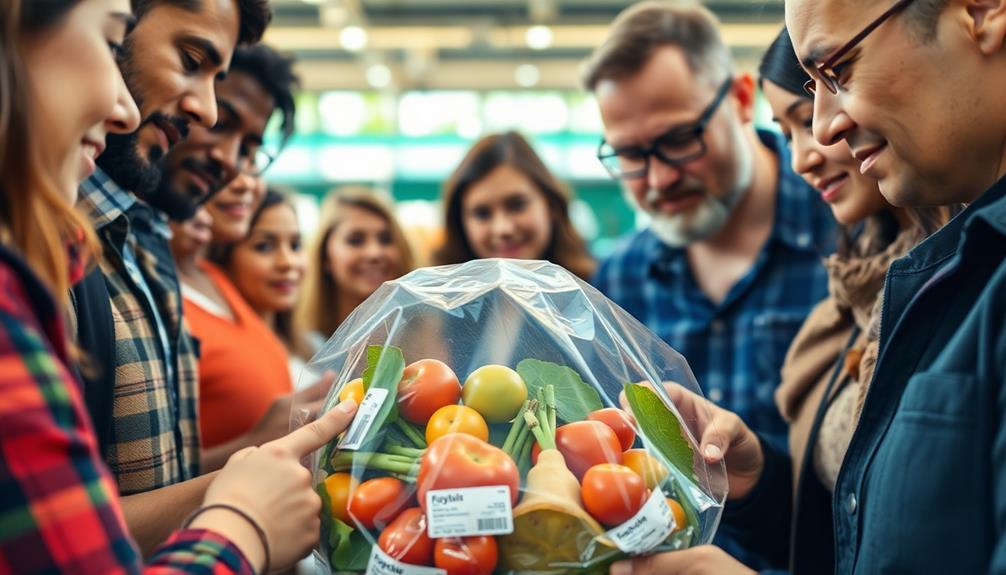
Transparent packaging plays an essential role in enhancing consumer trust and engagement with food products. When you can see what you're buying, it boosts your perception of product quality. This visual clarity allows you to assess food safety and quality easily, making it more likely that you'll choose organic food options. For instance, with Nettle and Potato Soup, the vibrant colors and fresh ingredients showcased in transparent packaging can highlight the dish's nutritional benefits.
The appeal of transparent packaging directly influences your purchase intentions, especially as you seek reliable, high-quality products.
Moreover, transparent packaging aligns with your preferences for environmental sustainability. Studies show that when you can see the product, you're more likely to feel connected to eco-friendly practices. This connection heightens your green purchasing intentions, particularly as you become increasingly aware of ecological concerns.
Clear labeling language on transparent packages reinforces your trust in the product, as it provides you with the information you need to make informed decisions.
The aesthetic appeal of transparent packaging not only satisfies your desire for visual engagement but also enhances the marketability of organic products. Ultimately, transparent packaging meets your expectations and fosters a stronger bond between you and the food you choose, driving your commitment to quality and sustainability.
Research Methodology and Findings

The impact of transparent packaging on consumer behavior has been the focus of recent research, revealing valuable insights about its effectiveness. A study involving 119 UK participants aged 18 to 58 assessed how transparent packaging influenced product evaluations across four categories, including food items like Red-Braised Pork Belly and snacks.
The findings showed that transparent packaging notably boosted purchase intentions, enhancing perceived freshness and food quality and safety. You'd likely feel a greater willingness to pay for products in transparent packages compared to opaque ones.
The empirical research demonstrated that transparency in packaging positively influenced consumer trust by increasing the perceived attractiveness and tastiness of the products. Additionally, the study accounted for aesthetic considerations, showing that visually appealing transparent packaging correlated with higher purchase intentions and overall consumer satisfaction.
Despite a minor data loss affecting a few participants, the study design proved reliable, yielding robust results across various product categories like pasta, chocolates, salmon, and granola.
These insights emphasize the critical role of transparent packaging in shaping purchasing decisions, making it an essential consideration for brands aiming to enhance consumer trust and engagement.
Effects on Consumer Behavior

When you see a product in transparent packaging, you're more likely to assess its quality visually, which can influence your buying decision.
This transparency builds trust, especially when it comes to organic foods, making you feel more confident about what you're purchasing.
Additionally, the emphasis on fresh ingredients, similar to how Brazilian cuisine showcases local produce like cassava and seafood, can further enhance this perception of quality.
Plus, if you're eco-conscious, knowing the brand cares about clear packaging can sway your choice toward greener options.
Visual Quality Assessment
Seeing food through transparent packaging can greatly influence your perception of quality and safety. When you can visually assess food quality and ingredients, it reinforces your consumer trust and increases the likelihood of choosing organic options perceived as fresher and safer.
Research shows that products in transparent packaging are often seen as more attractive and of higher quality, which makes you more willing to pay compared to those in opaque packages.
The appealing visuals in transparent packaging don't just look good; they evoke sensory responses that heighten your taste expectations and cravings. This connection to what you can see plays a significant role in your purchase decision-making.
You're likely to feel a stronger bond with products when you can monitor their freshness, enhancing your perceived food safety.
Aesthetic considerations matter too; attractive visuals in transparent packages correlate with increased purchase intentions across various product categories.
Trust Through Transparency
Transparent packaging not only enhances visual appeal but also builds consumer trust by allowing you to inspect the food's quality and ingredients directly. When you can see what you're buying, you're likely to feel more confident about its freshness and overall quality. This visual inspection reinforces your perception of the product, especially with organic food items, which often come with heightened expectations.
Research shows that transparent packaging greatly boosts your purchase intentions. You appreciate knowing the nutritional information and product attributes upfront, which helps you make informed decisions. This transparency also fosters brand loyalty, as you're more inclined to trust brands that openly communicate their offerings.
Moreover, transparent packaging isn't just about aesthetics; it aligns with your ecological concerns. Studies indicate that when you're faced with transparent packaging, you're more likely to reflect on the ecological impact of your purchase.
Consequently, the connection between transparent packaging and consumer trust becomes clear. By choosing products that showcase their quality and integrity, you're not only satisfying your immediate needs but also supporting brands that prioritize transparency and responsibility.
Eco-conscious Buying Decisions
With a growing emphasis on sustainability, eco-conscious buying decisions have become pivotal in shaping consumer behavior.
You're likely to notice how transparent packaging enhances your trust in products, especially when it comes to organic foods. This clarity allows you to assess food quality and ingredients, reinforcing your confidence in sustainability claims.
Here are three key factors influencing your eco-conscious buying choices:
- Informed Decision-Making: Transparent packaging communicates product attributes clearly, making it easier for you to choose eco-friendly options.
- Environmental Consciousness: When you see transparent packaging, it raises your awareness about the environmental impact of your purchasing choices, aligning with your values.
- Consumer Trust: As you engage with brands that value transparency, your trust in them grows, prompting you to support their sustainable initiatives.
Tourists and consumers alike are increasingly favoring products that showcase their commitment to sustainability.
This shift highlights how transparent packaging not only meets consumer expectations but also fosters lasting eco-conscious buying habits, ultimately benefiting both you and the planet.
Factors Influencing Purchase Decisions

When consumers can see the quality and ingredients of a product clearly, their trust in the brand increases substantially. Transparent packaging plays a vital role in shaping your purchase decisions. When you can easily assess freshness and safety, your confidence in the product heightens.
Research shows that when products are presented in transparent packaging, you're more likely to lean toward eco-conscious choices, particularly regarding organic food.
The aesthetic appeal of transparent packaging can't be overlooked. You likely find it more visually pleasing than opaque alternatives, which can influence your perception of product quality.
The visual cues offered by clear packaging—like vibrant colors and textures—effectively communicate attributes that enhance your expectations for taste and quality.
Additionally, your ecological concerns and connection to nature are positively impacted by transparent packaging, which can drive your intent to purchase sustainable products.
By choosing brands that prioritize transparency, you not only support your own values but also foster a market that prioritizes sustainability and quality.
Ultimately, the clarity offered by transparent packaging builds consumer trust and shapes your purchase decisions in significant ways.
Visual Appeal and Trust

The visual appeal of packaging greatly shapes your trust in a product. When you see transparent packaging, it not only allows you to assess food quality but also enhances your perception of freshness and safety.
Here are three significant ways visual appeal impacts your consumer trust:
- Aesthetic Appeal: Attractive packaging design captures your attention, making the product more desirable. Transparent materials often convey a sense of honesty, boosting your willingness to pay more.
- Enhanced Purchase Intentions: When you can see the product inside, it reinforces your belief in its authenticity. This transparency often translates into higher purchase intentions, especially for organic foods.
- Stronger Sensory Responses: The visual clarity of transparent packaging can trigger feelings of hunger or cravings, positively influencing your consumer evaluations. You're likely to associate visible quality with better taste and freshness.
Ultimately, transparent packaging plays an essential role in shaping your trust in food products. If the contents match your expectations, your confidence in the brand strengthens, leading to loyalty and repeat purchases.
Implications for Retail Strategies
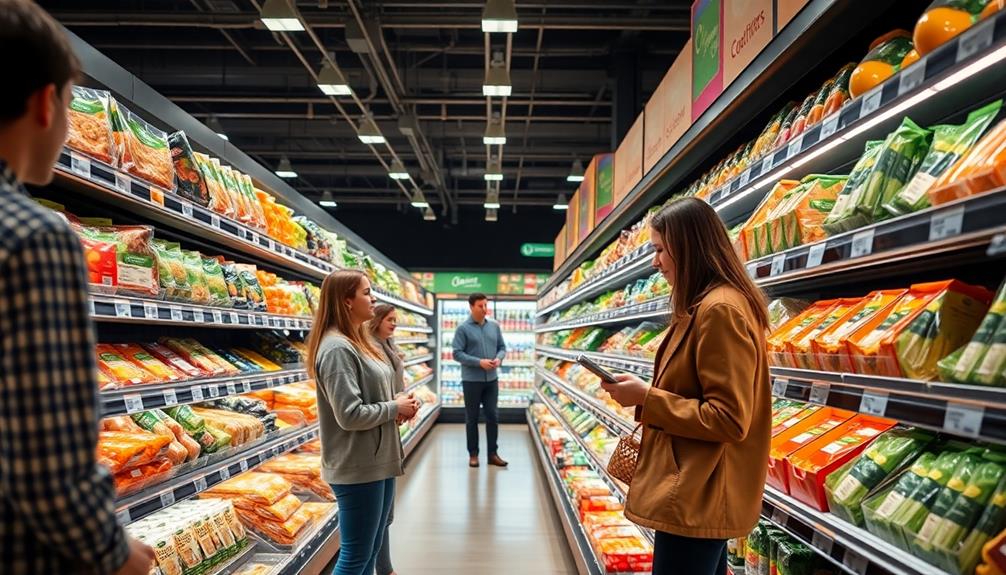
Retail strategies need to adapt to the growing consumer preference for transparent packaging, as studies show that 65% of shoppers are more likely to choose products that allow them to see what's inside.
By embracing transparent packaging, you can greatly enhance consumer trust and boost purchase intentions, particularly for organic and sustainably sourced products. Customers today aren't only concerned about food quality but also about product origins and ethical practices.
Incorporating transparent packaging into your retail strategies aligns with this ecological concern, appealing to those who value sustainability.
The visual clarity of these packages allows consumers to assess freshness and quality directly, reinforcing their trust in your brand.
Furthermore, aesthetically pleasing transparent packaging is more engaging than opaque alternatives, improving the marketability of your products in crowded retail spaces.
By providing clear insights into what's inside, you foster a connection with shoppers that encourages loyalty and repeat purchases.
Ultimately, adapting your retail strategies to include transparent packaging can set you apart in a competitive market, catering to the evolving preferences of conscious consumers.
Frequently Asked Questions
Why Is Transparency Important in Food Packaging?
Transparency in food packaging matters because it allows you to see the quality and ingredients of what you're buying. It helps you make informed choices, fostering trust and confidence in the products you consume.
How Does Food Packaging Affect the Consumer?
Food packaging affects you by influencing your perceptions of quality and freshness. When you see appealing designs or clear labels, you're more likely to trust the product, making you feel confident in your purchase decisions.
Why Is Transparency and Trust Important to Consumers?
You know the saying, "Honesty is the best policy." Transparency and trust matter to you because they empower informed choices, boost your confidence in products, and nurture a deeper connection with brands that value your health and safety.
How Does Packaging Affect Consumer Satisfaction?
Packaging greatly affects your satisfaction by influencing your perception of a product's freshness and quality. When you see appealing, transparent packaging, you're more likely to feel compelled to buy and enjoy the product.
Conclusion
To sum up, transparent food packaging greatly boosts consumer trust, with 73% of shoppers more likely to purchase products with clear ingredient listings. When you see what's inside, you're not just buying a product; you're investing in a brand that values honesty. This transparency shapes your choices and loyalty, leading retailers to rethink their strategies. By prioritizing openness, brands can create lasting connections with you, fostering a sense of confidence in every purchase you make.
Lifestyle
Why Certain Foods Are Linked to Improved Focus and Concentration
Keen insights reveal how specific foods can enhance your focus and concentration, but which ones truly make a difference for your brain health?

Certain foods boost your focus and concentration by supplying essential nutrients that support brain health. For instance, omega-3 fatty acids found in fatty fish help maintain brain cell function, while leafy greens improve neuron communication. Berries, especially blueberries, are packed with antioxidants that enhance memory. Hydration is equally important; staying hydrated sharpens your thinking. Regular meals, particularly a balanced breakfast, keep your energy steady throughout the day. Incorporating these brain-boosting foods into your diet can elevate your cognitive performance. Discover more about the foods that fuel your mind and help you stay sharp.
Key Takeaways
- Omega-3 fatty acids from fatty fish support brain cell function and enhance cognitive performance, improving focus and reducing cognitive decline risk.
- Leafy greens boost neuron communication and provide sustained energy through vitamins and flavonoids, enhancing overall brain efficiency and concentration.
- Berries, especially blueberries, contain antioxidants that protect neurons and improve memory retention, contributing to better focus during cognitive tasks.
- Avocados enhance blood flow to the brain and stabilize energy levels, which helps maintain motivation and cognitive performance throughout the day.
- Proper hydration is essential for cognitive function, as adequate water intake can enhance thinking speed and prevent distraction due to brain fatigue.
Brain-Boosting Nutrients

When it comes to enhancing your focus and concentration, incorporating brain-boosting nutrients into your diet can make a significant difference. Start by including omega-3 fatty acids, which are found in fatty fish like salmon and sardines. These essential fats support brain health, improve memory, and enhance cognitive function, especially in older adults.
Additionally, consider the benefits of Brazilian seafood dishes, such as Caldeirada, which are rich in these essential nutrients.
Don't overlook the power of leafy greens, either. Nutrients like vitamin K, prevalent in these vegetables, play an important role in slowing cognitive decline and maintaining brain structure.
You might also want to add berries to your meals; their flavonoids boost memory retention and cognitive performance. Studies show that just two servings a week can delay memory decline by up to 2.5 years.
Additionally, consider antioxidants such as vitamin E and curcumin from turmeric. They fight oxidative stress in the brain, potentially improving cognitive clarity and focus.
The Role of Caffeine

Caffeine plays an essential role in enhancing your focus and concentration, offering a quick boost to alertness and cognitive performance. Found in coffee, tea, and energy drinks, caffeine works by blocking adenosine receptors in your brain, reducing feelings of fatigue.
Additionally, certain foods, like Red-Braised Pork Belly, can provide a rich source of energy, which may complement the effects of caffeine. When consumed in moderation, typically around 200-300 mg, you can experience improved mental function, including better focus and memory retention. This makes it a popular choice among students and professionals tackling complex tasks.
However, it's crucial to be mindful of your caffeine intake. While it can temporarily enhance cognitive abilities, excessive consumption may lead to jitteriness, anxiety, and disrupted sleep patterns, all of which can negatively impact your focus and attention.
Research indicates that caffeine not only boosts short-term cognitive performance but also helps solidify new memories, with effects lasting for several hours after consumption.
To maximize the benefits, consider limiting your caffeine intake in the afternoon to avoid compromising your sleep quality. Quality rest is essential, as poor sleep can counteract the advantages gained from caffeine, ultimately affecting your overall cognitive performance.
Importance of Breakfast

Starting your day with breakfast is essential for enhancing focus and concentration. Studies show that consuming a morning meal boosts cognitive function, particularly improving short-term memory. Foods rich in nutrients, such as those found in Nettle and Potato Soup, can provide the vital vitamins and minerals your brain craves.
If you're a student, having breakfast can greatly elevate your academic performance. Opt for high-fiber grains, dairy products, and fruits to provide the necessary nutrients your brain craves. These foods help stabilize your energy levels, allowing you to concentrate better throughout the morning.
However, be mindful of portion control. Overeating at breakfast can negatively impact your concentration, leading to feelings of sluggishness and distraction. Aim for a balanced meal that fuels your body without overwhelming it. Regularly eating breakfast not only prevents hunger-related distractions later in the day but also guarantees your mind stays sharp.
On the flip side, skipping breakfast can lead to decreased attention and cognitive performance. When you don't eat in the morning, you're setting yourself up for a struggle with focus.
Omega-3 Fatty Acids
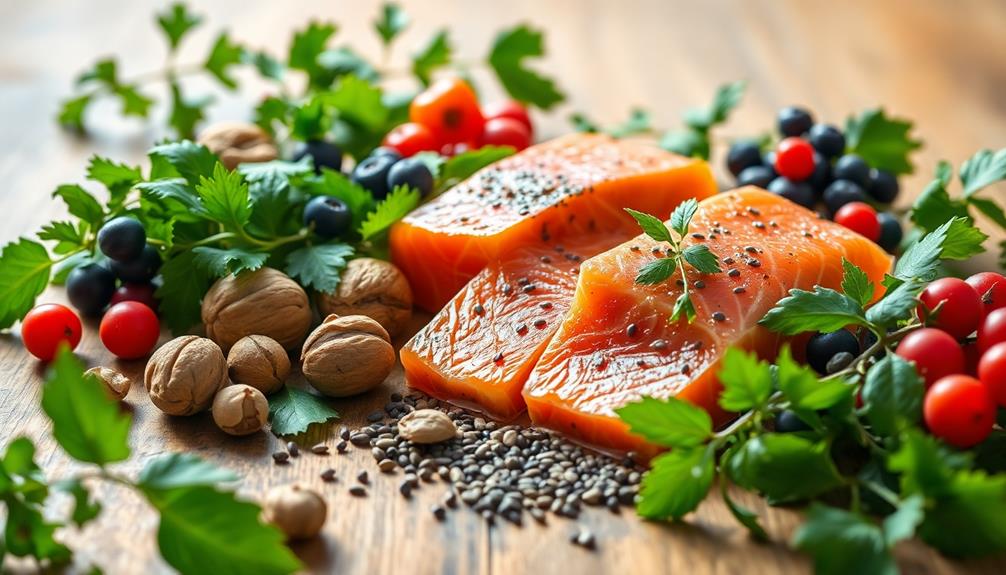
Breakfast sets the tone for your cognitive performance, but to truly enhance focus throughout the day, incorporating omega-3 fatty acids into your diet is key. These essential fats, especially DHA (docosahexaenoic acid), are crucial for maintaining brain cell structure and function, directly impacting your cognitive function. By including omega-3s in your meals, you can boost your memory and improve overall brain health.
Research shows that higher levels of omega-3 fatty acids are linked to a lower risk of developing Alzheimer's disease and cognitive decline, particularly in older adults. Eating fatty fish like salmon and mackerel twice a week can help you achieve adequate omega-3 intake. This simple dietary change can't only support your focus but also promote long-term brain health.
Moreover, regular consumption of omega-3s increases levels of BDNF (brain-derived neurotrophic factor), essential for synaptic plasticity. This means that your brain can adapt and grow, enhancing learning and memory capabilities.
Hydration and Cognitive Function

Hydration plays an essential role in maintaining your cognitive function and focus throughout the day. Water makes up about 85% of your brain, which means staying well-hydrated is critical for ideal brain function. When you're not drinking enough, you might experience focus problems, brain fatigue, and even headaches, all of which can hinder your cognitive abilities.
Studies have shown that adequate water intake can enhance your thinking speed by up to 14%, greatly improving mental clarity. Hydration also supports the production of neurotransmitters, which are essential for executive functioning and various cognitive processes.
Here's a quick reference for recommended daily water intake:
| Gender | Daily Water Intake |
|---|---|
| Men | 3.7 liters |
| Women | 2.7 liters |
| Active Lifestyle | More may be needed |
| Age & Health | Individual needs vary |
Nutrient-Dense Foods
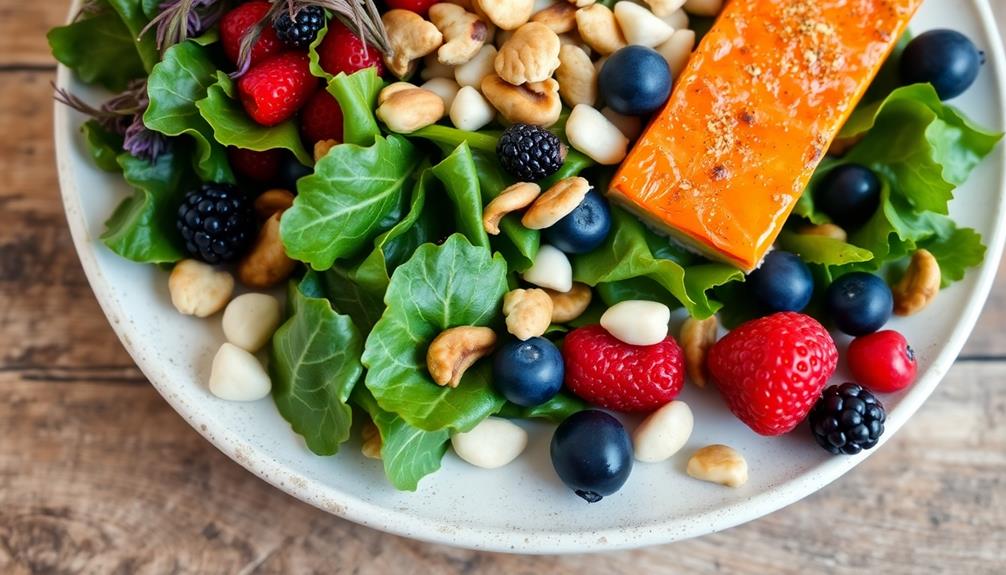
When you want to boost your focus and concentration, nutrient-dense foods should be on your plate.
Blueberries, avocados, and leafy greens are packed with brain-boosting benefits that can enhance your cognitive performance.
Incorporating these foods into your diet can help you stay sharp and motivated throughout the day.
Blueberries Enhance Cognitive Performance
Incorporating blueberries into your diet can substantially enhance your cognitive performance and focus. These small, nutrient-dense berries are packed with flavonoids that improve memory and boost cognitive function by increasing oxygen and blood flow to the brain.
Research shows that just one serving of blueberries can enhance your concentration and memory for up to five hours, whereas those who don't consume them may experience a notable 15-20% decline in performance.
Moreover, blueberries are rich in antioxidants, vitamin C, and vitamin E, all of which play an essential role in promoting brain health and protecting neurons from damage.
A study from Harvard even revealed that regular consumption of blueberries could delay memory decline by as much as 2.5 years, underscoring their importance for long-term cognitive health.
You can easily include blueberries in your meals, whether in smoothies, cereals, or as a snack.
By making this simple addition to your diet, you're not only enjoying a delicious treat but also actively enhancing your cognitive abilities and supporting your brain health.
Avocado's Brain-Boosting Benefits
Avocados are a powerhouse of nutrients that can considerably boost your brain health and cognitive function. Packed with monounsaturated fats, they enhance blood flow to the brain, supporting overall cognitive performance. The presence of tyrosine in avocados helps produce dopamine, which increases motivation and focus. Including avocados in your diet can definitely give you that extra mental edge.
Here's a quick comparison of avocado's benefits:
| Nutrient | Benefit | Source |
|---|---|---|
| Monounsaturated Fats | Improves blood flow | Avocado |
| Tyrosine | Enhances motivation | Avocado |
| Vitamin K | Provides neuroprotection | Avocado |
| Folate | Supports brain health | Avocado |
The healthy fats in avocados also stabilize your energy levels, preventing those dreaded cognitive dips often linked to sugary snacks. Regularly consuming avocados can enhance neuron communication and overall brain efficiency. So, if you're looking to improve your focus and concentration, adding avocados to your meals is a smart and delicious choice!
Leafy Greens for Focus
Boosting your focus and concentration can be as simple as adding leafy greens to your diet. Leafy vegetables like spinach and kale are packed with essential nutrients such as vitamin K, lutein, folate, and beta carotene, all linked to improved cognitive function.
Regularly consuming these greens can enhance neuron communication and increase brain efficiency, which benefits your overall mental clarity and focus.
Spinach stands out for its potassium, iron, and vitamin B content, helping combat stress and elevate your mood, leading to better concentration.
Research shows that diets rich in fruits and vegetables, particularly those loaded with flavonoids found in leafy greens, can enhance attention and cognitive performance.
When you incorporate these nutrient-dense foods into your meals, you're not just nourishing your body; you're providing a natural source of energy that supports sustained focus throughout the day.
Long-Term Dietary Strategies
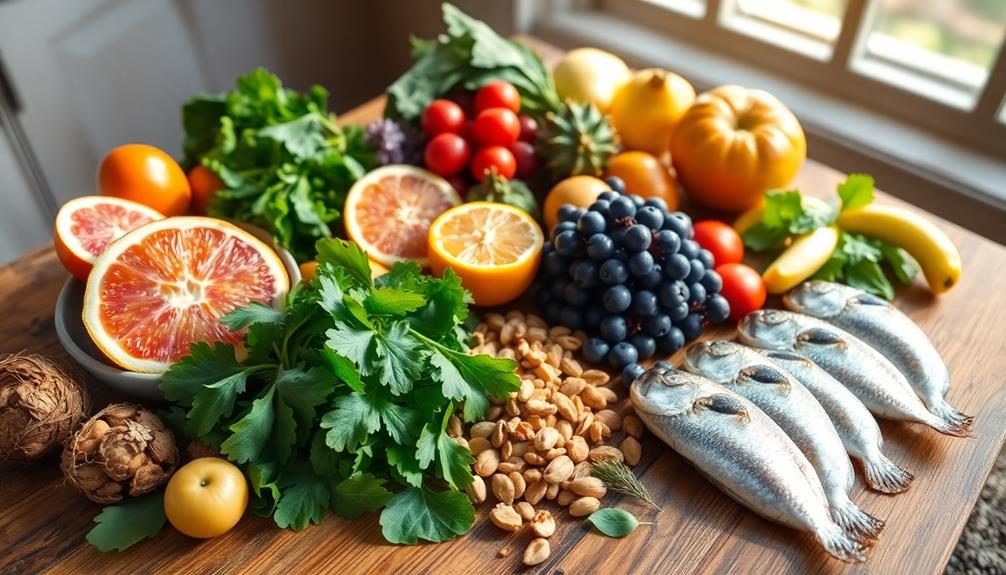
To boost your focus and concentration over the long term, it's essential to choose nutrient-rich foods consistently.
A balanced diet that includes plenty of fruits, vegetables, and healthy fats, along with staying hydrated, plays a key role in supporting cognitive function.
Nutrient-Rich Food Choices
A well-rounded diet packed with nutrient-rich foods can greatly enhance your focus and concentration over time. Incorporating leafy greens, berries, and fatty fish into your meals provides essential vitamins and omega-3 fatty acids that support brain health and cognitive function.
For instance, blueberries are rich in antioxidants, helping to improve blood flow to the brain, which boosts memory retention and concentration.
Regularly consuming whole grains guarantees you maintain stable glucose levels. This stability is essential for sustained energy and focus throughout your day.
Additionally, foods like avocados and walnuts offer healthy fats that improve neurotransmitter function, important for effective communication between neurons.
You should prioritize a balanced diet emphasizing plant-based foods, healthy fats, and lean proteins. This approach not only enhances your cognitive function but also greatly reduces the risk of cognitive decline.
Hydration and Cognitive Function
Maintaining hydration is just as essential as choosing the right foods for enhancing focus and concentration. Water makes up about 85% of your brain, so staying hydrated is vital for ideal cognitive function.
When you're dehydrated, you may experience decreased attention, increased fatigue, and difficulty processing information. Research shows that proper hydration can boost your thinking speed by up to 14%, markedly improving overall cognitive performance.
To help you prioritize hydration, consider these tips:
- Carry a water bottle: Keep it within reach to remind yourself to drink throughout the day.
- Set reminders: Use your phone or apps to prompt you to hydrate regularly.
- Link water to routines: Drink a glass of water before meals or after a bathroom break.
- Flavor it up: Add fruits or herbs to your water for a revitalizing twist.
- Track your intake: Use a journal or app to monitor your daily water consumption.
Balanced Diet Importance
Eating a balanced diet is vital for sustaining focus and enhancing cognitive function over time. A diet rich in fruits and vegetables, whole grains, and healthy fats supports your cognitive health, helping you stay sharp and attentive.
Nutrient-dense foods, such as fatty fish packed with omega-3 fatty acids, leafy greens, and antioxidant-rich berries, can greatly enhance memory retention and cognitive abilities, particularly as you age.
Regularly consuming breakfast is essential, too. It's been linked to improved attention and academic performance in children and teens, highlighting the importance of consistent meal patterns for everyone.
Incorporating a variety of foods guarantees your brain receives the nutrients it needs to function at its best.
Moreover, diets high in antioxidants, vitamins, and omega-3 fatty acids combat inflammation and oxidative stress, both of which can lead to cognitive decline and diminished concentration.
Staying hydrated is also part of maintaining a balanced diet, as even mild dehydration can negatively impact your focus.
Frequently Asked Questions
What Food May Improve Concentration and Focus?
To improve your concentration and focus, try incorporating blueberries, fatty fish, avocados, and leafy greens into your diet. These foods offer essential nutrients that can enhance brain function and keep your mind sharp throughout the day.
What Foods Make You Focus Better?
Think of your brain as a finely-tuned engine; it needs quality fuel. Eating blueberries, fatty fish, avocados, leafy greens, and whole grains can supercharge your focus, keeping your mind sharp and ready for action.
What Are the Reasons for Food Concentration?
When you eat certain foods, your brain gets essential nutrients that boost energy and function. These nutrients improve blood flow and support cognitive performance, helping you stay alert, focused, and ready to tackle tasks effectively.
How Does Nutrition Improve Focus?
Oh sure, you think nutrition's just about avoiding junk? Well, when you fuel your brain with nutrient-dense foods, hydration, and healthy fats, you actually sharpen your focus, boost concentration, and keep cognitive decline at bay.
Conclusion
To enhance your focus and concentration, incorporating brain-boosting nutrients into your diet is essential. Foods rich in omega-3 fatty acids, staying hydrated, and starting your day with a nutritious breakfast can make a significant difference. Don't forget about caffeine's role in sharpening your mental clarity. With the right nutrient-dense foods, why wouldn't you want to fuel your brain for better performance? By making these dietary choices, you're setting yourself up for success in every task you tackle.
-

 Vetted5 months ago
Vetted5 months ago14 Best Personalized Father's Day Gifts for Your Husband – Show Him You Care
-

 Alfresco5 months ago
Alfresco5 months agoAlfresco Stacker Doors: Seamless Indoor-Outdoor Living!
-

 Vetted6 months ago
Vetted6 months ago15 Best EMS Foot Massagers for Neuropathy to Soothe Your Feet
-

 Craft and Textiles7 months ago
Craft and Textiles7 months ago15 Best Places to Buy Appliances for Your Home – Top Retailers Reviewed
-

 Vetted5 months ago
Vetted5 months agoBattle Born Batteries Review: Reliable Power Solution
-

 Vetted5 months ago
Vetted5 months agoD-Link Switch Review: Lite Layer 3 Managed Networking
-

 Tableware and Dining Accessories7 months ago
Tableware and Dining Accessories7 months agoWhat Is the Meaning of the Word Tableware
-

 Tableware and Dining Accessories7 months ago
Tableware and Dining Accessories7 months agoWhat Is the Hindi Meaning of Tableware





























